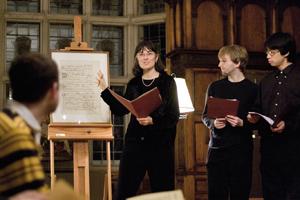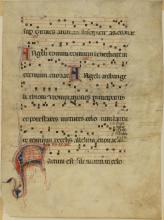By Emily Gold Boutilier
 |
For a half century, the Mead Art Museum needed a good detective.
In the 1950s and 1960s the museum received, from separate donors, two pages from manuscripts containing
mysterious, archaic musical notation and Latin text so hard to read that it seemed to be in code.
“We couldn’t decipher them,” says Elizabeth Barker, director and chief curator of the museum. Decorations
on the manuscripts led the curators to believe that they were from 14th-century Italy, but the museum knew
virtually nothing else about them, Barker says. The musical notation barely resembled modern-day sheet music. “We only knew what we could see on the surface.”
 |
Enter the students in “Music 21: Music and Culture.” Last semester, these 14 men and women became sleuths, unraveling the mystery of the musical manuscripts.
Their professor, Klára Móricz, presented the cold case early in the semester. Working in groups, the students set out to transpose two manuscript pages into modern musical notation, to decode and translate the Latin and to learn when the music might have been performed.
The case was an opportunity to apply a classroom lesson to a real-world problem. The students recognized the archaic music as quadratic notation, which they’d learned to read in class. In groups, they set about transposing the music into a form that today’s performers could understand. They identified the music as chants.
“More difficult,” says Music 21 student Jeremy Koo ’12, “was trying to decipher the Latin.” But they had more than just music education on their side: “Lo and behold,” says Hilary Budwey ’13, “there were a few kids in the class who’d taken Latin.” She was one of them.
The text, however, was a hostile witness. “A lot of the letters were faded,” says Budwey. “That was the first problem.” Posing another challenge, the unusual calligraphy made it “difficult to tell what letters were really what,” she says. To make matters worse, the manuscripts featured strange Latin abbreviations that Budwey and her classmates had never before encountered.
 |
But never underestimate a liberal arts student. After deciphering several abbreviations and phrases, the students used computer databases to identify the type of liturgical books that would have contained such chants and the services during which such chants were sung. As it turned out, one chant was sung at the Feast of St. Michael the Archangel—which happened to be the date that the projects were due—while the other was from the fourth Sunday of Advent. The students deduced that the pages are from manuscripts for Gregorian chants.
The Mead was thrilled—not only that the mystery was solved but also that Móricz had used the museum’s collection “not as a garnish” to coursework, Barker says, but as the “main dish, letting students sink their intellectual forks into it.”
The detectives met at the Mead in December to perform a concert of the chants. As one Music 21 student put it, they’d breathed new life into dead music.
![]() Listen to an audio clip of students chanting “Princeps.” Play below, or download the MP4.
Listen to an audio clip of students chanting “Princeps.” Play below, or download the MP4.
![]() Listen to an audio clip of students chanting “Angeli, Archangeli.” Play below, or download the MP4.
Listen to an audio clip of students chanting “Angeli, Archangeli.” Play below, or download the MP4.
Manuscript image courtesy of Mead Art Museum. Other photos by Jessica Mestre ’10.